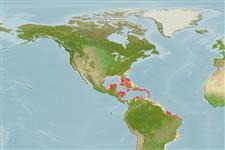>
Ovalentaria/misc (Various families in series Ovalentaria) >
Pomacentridae (Damselfishes) > Microspathodontinae
Etymology: Stegastes: Greek, stegastos, -e, -on = covered (Ref. 45335).
More on author: Cuvier.
Environment: milieu / climate zone / depth range / distribution range
Ekologi
laut berasosiasi dengan karang; nir-ruaya; kisaran kedalaman 1 - 30 m (Ref. 7247). Tropical
Western Atlantic: including southern Florida (USA), Bahamas, and the Caribbean Sea.
Size / Weight / umur
Maturity: Lm ? range ? - ? cm
Max length : 13.0 cm TL jantan/; (Ref. 26340)
deskripsi pendek
Kunci identifiaksi (pengenalan) | Morfologi | Morfometrik
Duri punggung (Keseluruhan (total)) : 12; duri punggung lunak (Keseluruhan (total)) : 15 - 17; Duri dubur: 2; Sirip dubur lunak: 13 - 14. Adults brownish gray with a yellowish cast; vertical dark lines following scale rows; a large blackish spot covering most of pectoral base, darkest near upper part; pectorals slightly dusky. The young are bright yellow with a large black spot at base of dorsal fin at junction of spinous and soft portions, a large black spot dorsally on caudal peduncle and a small one at upper pectoral base (Ref. 13442).
Adults inhabit inshore and offshore coral reefs. They are found within caves at night (Ref. 9626). Often found in tangles of staghorn coral; anywhere there is abundant algae on reefs (Ref. 26938). Feed mainly on algae but also on harpacticoid copepods, small gastropods, eggs of mollusks, sponges, polychaetes and hydroids (Ref. 9626). Juveniles subsist on the external parasites of fishes (Ref. 5521). Adults pugnaciously guard large territories, will chase and nip intruders of all sizes, including divers (Ref. 9710). Oviparous, distinct pairing during breeding (Ref. 205). Eggs are demersal and adhere to the substrate (Ref. 205). Males guard and aerate the eggs (Ref. 205). Taken incidentally in traps and small-meshed beach nets (Ref. 5217).
Life cycle and mating behavior
Maturities | Reproduksi, perkembang biakan | Spawnings | Egg(s) | Fecundities | Larva
Oviparous, distinct pairing during breeding (Ref. 205). Eggs are demersal and adhere to the substrate (Ref. 205). Males guard and aerate the eggs (Ref. 205).
Allen, G.R., 1991. Damselfishes of the world. Mergus Publishers, Melle, Germany. 271 p. (Ref. 7247)
Status IUCN Red List (Ref. 130435)
ancaman kepada manusia
Harmless
penggunaan manusia
Perikanan: komersial; Akuarium: Komersial
Alat, peralatan
laporan khas
muat turun XML
Sumber internet
Estimates based on models
Preferred temperature (Ref.
123201): 25.6 - 28.2, mean 27.4 °C (based on 672 cells).
Phylogenetic diversity index (Ref.
82804): PD
50 = 0.5000 [Uniqueness, from 0.5 = low to 2.0 = high].
Bayesian length-weight: a=0.02042 (0.01172 - 0.03557), b=2.97 (2.82 - 3.12), in cm total length, based on LWR estimates for this species & Genus-body shape (Ref.
93245).
Trophic level (Ref.
69278): 3.3 ±0.3 se; based on diet studies.
Generation time: 3.3 ( na - na) years. Estimated as median ln(3)/K based on 2
growth studies.
Daya lenting (Ref.
120179): Tinggi, Waktu penggandaan populasi minimum kurang dari 15 bulan (K=0.33-0.58).
Fishing Vulnerability (Ref.
59153): Low vulnerability (24 of 100).
Nutrients (Ref.
124155): Calcium = 96.4 [49.3, 151.3] mg/100g; Iron = 0.71 [0.42, 1.14] mg/100g; Protein = 18.5 [17.4, 19.6] %; Omega3 = 0.12 [0.07, 0.19] g/100g; Selenium = 24.3 [13.9, 44.1] μg/100g; VitaminA = 88.4 [26.4, 283.0] μg/100g; Zinc = 1.47 [1.00, 2.10] mg/100g (wet weight);
